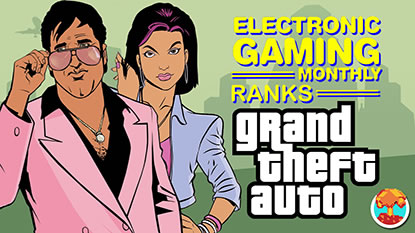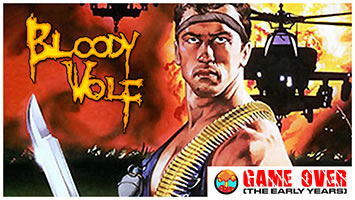- CLASSIC MAGAZINES
- REVIEW CREW
A show recapping what critics thought back
when classic games first came out! - NEXT GENERATION'S BEST & WORST
From the worst 1-star reviews to the best
5-stars can offer, this is Next Generation! - NINTENDO POWER (ARCHIVE)
Experience a variety of shows looking at the
often baffling history of Nintendo Power! - MAGAZINE RETROSPECTIVE
We're looking at the absolutely true history of
some of the most iconic game magazines ever! - SUPER PLAY'S TOP 600
The longest and most ambitious Super NES
countdown on the internet! - THEY SAID WHAT?
Debunking predictions and gossip found
in classic video game magazines! - NEXT GENERATION UNCOVERED
Cyril is back in this spin-off series, featuring the
cover critic review the art of Next Generation! - HARDCORE GAMER MAGAZING (PDF ISSUES)
Download all 36 issues of Hardcore Gamer
Magazine and relive the fun in PDF form!
- REVIEW CREW
- ELECTRONIC GAMING MONTHLY
- ELECTRONIC GAMING MONTHLY RANKS
From Mario to Sonic to Street Fighter, EGM
ranks classic game franchises and consoles! - ELECTRONIC GAMING MONTHLY BEST & WORST
Counting down EGM’s best and worst reviews
going year by year, from 1989 – 2009! - ELECTRONIC GAMING BEST & WORST AWARDS
11-part video series chronicling the ups and
downs of EGM’s Best & Worst Awards!
- ELECTRONIC GAMING MONTHLY RANKS
- GAME HISTORY
- GAME OVER: STORY BREAKDOWNS
Long-running series breaking down game
stories and analyzing their endings! - A BRIEF HISTORY OF GAMING w/ [NAME HERE]
Real history presented in a fun and pithy
format from a variety of game historians! - THE BLACK SHEEP
A series looking back at the black sheep
entries in popular game franchises! - INSTANT EXPERT
Everything you could possibly want to know
about a wide variety of gaming topics! - FREEZE FRAME
When something familiar happens in the games
industry, we're there to take a picture! - I'VE GOT YOUR NUMBER
Learn real video game history through a series
of number-themed episodes, starting at zero! - GREAT MOMENTS IN BAD ACTING
A joyous celebration of some of gaming's
absolute worst voice acting!
- GAME OVER: STORY BREAKDOWNS
- POPULAR SHOWS
- DG NEWS w/ LORNE RISELEY
Newsman Lorne Riseley hosts a regular
series looking at the hottest gaming news! - REVIEW REWIND
Cyril replays a game he reviewed 10+ years
ago to see if he got it right or wrong! - ON-RUNNING FEUDS
Defunct Games' longest-running show, with
editorials, observations and other fun oddities! - DEFUNCT GAMES QUIZ (ARCHIVE)
From online quizzes to game shows, we're
putting your video game knowledge to the test!- QUIZ: ONLINE PASS
Take a weekly quiz to see how well you know
the news and current gaming events! - QUIZ: KNOW THE GAME
One-on-one quiz show where contestants
find out if they actually know classic games! - QUIZ: THE LEADERBOARD
Can you guess the game based on the classic
review? Find out with The Leaderboard!
- QUIZ: ONLINE PASS
- DEFUNCT GAMES VS.
Cyril and the Defunct Games staff isn't afraid
to choose their favorite games and more! - CYRIL READS WORLDS OF POWER
Defunct Games recreates classic game
novelizations through the audio book format!
- DG NEWS w/ LORNE RISELEY
- COMEDY
- GAME EXPECTANCY
How long will your favorite hero live? We crunch
the numbers in this series about dying! - VIDEO GAME ADVICE
Famous game characters answer real personal
advice questions with a humorous slant! - FAKE GAMES: GUERILLA SCRAPBOOK
A long-running series about fake games and
the people who love them (covers included)! - WORST GAME EVER
A contest that attempts to create the worst
video game ever made, complete with covers! - LEVEL 1 STORIES
Literature based on the first stages of some
of your favorite classic video games! - THE COVER CRITIC
One of Defunct Games' earliest shows, Cover
Critic digs up some of the worst box art ever! - COMMERCIAL BREAK
Take a trip through some of the best and
worst video game advertisements of all time! - COMIC BOOK MODS
You've never seen comics like this before.
A curious mix of rewritten video game comics!
- GAME EXPECTANCY
- SERIES ARCHIVE
- NINTENDO SWITCH ONLINE ARCHIVE
A regularly-updated list of every Nintendo
Switch Online release, plus links to review! - PLAYSTATION PLUS CLASSIC ARCHIVE
A comprehensive list of every PlayStation
Plus classic release, including links! - RETRO-BIT PUBLISHING ARCHIVE
A regularly-updated list of every Retro-Bit
game released! - REVIEW MARATHONS w/ ADAM WALLACE
Join critic Adam Wallace as he takes us on a
classic review marathon with different themes!- DEFUNCT GAMES GOLF CLUB
Adam Wallace takes to the links to slice his way
through 72 classic golf game reviews! - 007 IN PIXELS
Adam Wallace takes on the world's greatest spy
as he reviews 15 weeks of James Bond games! - A SALUTE TO VAMPIRES
Adam Wallace is sinking his teeth into a series
covering Castlevania, BloodRayne and more! - CAPCOM'S CURSE
Adam Wallace is celebrating 13 days of Halloween
with a line-up of Capcom's scariest games! - THE FALL OF SUPERMAN
Adam Wallace is a man of steel for playing
some of the absolute worst Superman games! - THE 31 GAMES OF HALLOWEEN
Adam Wallace spends every day of October afraid
as he reviews some of the scariest games ever! - 12 WEEKS OF STAR TREK
Adam Wallace boldly goes where no critic has
gone before in this Star Trek marathon!
- DEFUNCT GAMES GOLF CLUB
- DAYS OF CHRISTMAS (ARCHIVE)
Annual holiday series with themed-episodes
that date all the way back to 2001!- 2015: 30 Ridiculous Retro Rumors
- 2014: 29 Magazines of Christmas
- 2013: 29 Questionable Power-Ups of Christmas
- 2012: 34 Theme Songs of Christmas
- 2011: 32 Game Endings of Christmas
- 2010: 31 Bonus Levels of Christmas
- 2009: 30 Genres of Christmas
- 2008: 29 Controls of Christmas
- 2007: 34 Cliches of Christmas
- 2006: 33 Consoles of Christmas
- 2005: 32 Articles of Christmas
- 2004: 31 Websites of Christmas
- 2003: 29 Issues of Christmas
- 2002: 28 Years of Christmas
- 2001: 33 Days of Christmas
- NINTENDO SWITCH ONLINE ARCHIVE
- REVIEW ARCHIVE
- FULL ARCHIVE
The World According to Gunpei Yokoi

In this picture the original Game Boy looks small and light, but as we all know in reality the device was three feet tall and weighed around 80 pounds!
Born in 1941, Yokoi began working for the company that would define his life in 1965. Hiroshi Yamauchi, former head of Nintendo Co., Ltd., first took note of Yokoi in 1970 when he saw the man playing with an extendable arm that he had created. Dubbed the Ultra Hand, it quickly became a huge success, selling over a million units for the card-making company. He
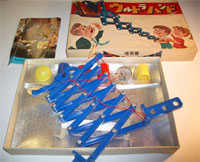
With the Ultra Hand you can grab stuff from a great distance, which is cool ... I guess!
In 1980, Nintendo released the Game & Watch series. Small handhelds featuring one hard-wired game, the Game & Watch series set itself apart from competitors early on. In a world where Space Invaders and Pong were the watch-words, Game & Watch offered an alternative style of gameplay on the go. Using segmented LCD screens, at least in the beginning, the series began with simple games such as Ball before adapting arcade and (later) NES games for the handheld. The hardware wasn't officially retired until 1991, with the release of Mario the Juggler. Perhaps the biggest element to come out of the Game & Watch hardware, however, was
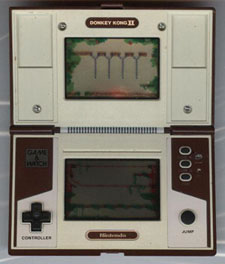
No you're not looking at an early prototype of the Nintendo DS, thie is the Game & Watch, the most fun alarm clock you'll ever own!

Thankfully Gunpei Yokoi had nothing to do with the terrible Game Boy comics!
The success of the Game & Watch led to Yokoi being made head of Research and Development 1. This section of Nintendo, until 1984, helped young designer Shigeru Miyamoto with games such as Donkey Kong, Donkey Kong, Jr., and Mario Bros. This development team also created R.O.B. the robot (an early accessory for the NES), Kid Icarus, and Metroid along with Super Mario Land and its sequels on the Game Boy.
In 1989, Yokoi and his R&D1 division released the device that would define his vision of gaming to the world, the Game Boy. This device was his attempt to redefine handheld gaming the way the NES redefined the home console. Using swappable game cartridges and running for several hours on four AA batteries, the Game Boy was the birth of the modern age of handheld video gaming. Despite Nintendo's desire for a color screen, Yokoi refused to implement one until technology allowed for it to be done without gobbling through batteries (see Atari Lynx and
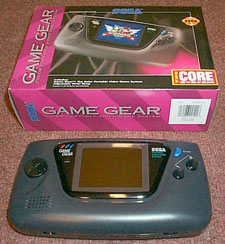
The Game Gear was big and black, but it also sucked battery life like nothing else (except for the Nomad, which only lasted an hour on six AA batteries)!
Through its life-span, and its successors, the Game Boy managed to beat off multiple competitors (all of which had superior elements), due to its addictive games, pick-up-and-play philosophy, and battery life. It delivered some of the most memorable game moments (for better or worse), such as the first Pokemon game, several fantastic
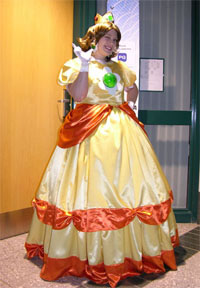
Without Gunpei Yokoi we wouldn't have to put up with fat girls in Princess Daisy costumers. Thanks Gunpei!
Gunpei Yokoi was never content to sit back and enjoy his success. Instead, he was always looking for new gameplay experiences that he could introduce. This natural curiosity ultimately led him to discover what would be known as the Virtual Boy. Released in 1995 at a price of $180, this curious creation was championed strongly by Yokoi, despite some glaring issues with the system that seemed to go against his natural instinct of fun. The red and black display, though capable of creating 3D playing fields, was also capable of creating massive headaches, requiring the player to pause every twenty to thirty minutes. The system wasn't portable, being a large headset the player looked
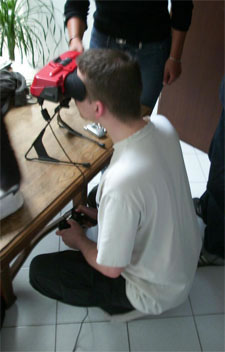
Like drinking using a straw, there's just no way you can look manly while sticking your head in the Virtual Boy!
Gunpei Yokoi had no desire to leave the world of video game entertainment behind, however, and almost immediately started the company, Koto Laboratory, where he began designing a new handheld game system in partnership with Bandai. This handheld would feature several unique elements, such as duplicate control pads to allow for vertical or horizontal playfields. It also used only one AA battery and was capable of running for thirty to forty hours
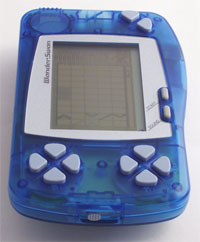
If you squint you might be able to make out Gunpey, the video game homage to the WonderSwan's creator!
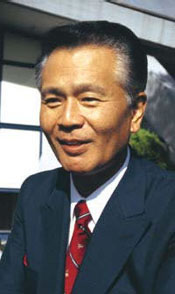
Rest in Peace, Gunpei Yokoi!
Gunpey was recently remade for the Sony PSP and (bringing it full circle) the Nintendo DS. Yokoi believed strongly in "lateral thinking of withered technology," which meant reinterpreting the technology that already existed instead of constantly seeking the newest and most expensive. When Yokoi left this motto behind, with the Virtual Boy, he experienced his one, truly biting failure. In the end, however, the Game Boy and the WonderSwan are what Gunpei Yokoi will be most fondly remembered for. This gentle, quiet-spoken man who sought to bring fun to the world was officially honored by the games industry in 2006, when he posthumously received the Lifetime Achievement Award at the Game Developer's Choice Awards ceremony on March 6, 2003. Metroid Prime, developed by Retro Studios and featuring Samus (one of his best known creations) won Game of the Year in the same ceremony.





HOME |
CONTACT |
NOW HIRING |
WHAT IS DEFUNCT GAMES? |
NINTENDO SWITCH ONLINE |
RETRO-BIT PUBLISHING
Retro-Bit |
Switch Planet |
The Halcyon Show |
Same Name, Different Game |
Dragnix |
Press the Buttons
Game Zone Online | Hardcore Gamer | The Dreamcast Junkyard | Video Game Blogger
Dr Strife | Games For Lunch | Mondo Cool Cast | Boxed Pixels | Sega CD Universe | Gaming Trend
Game Zone Online | Hardcore Gamer | The Dreamcast Junkyard | Video Game Blogger
Dr Strife | Games For Lunch | Mondo Cool Cast | Boxed Pixels | Sega CD Universe | Gaming Trend
Copyright © 2001-2025 Defunct Games
All rights reserved. All trademarks are properties of their respective owners.
All rights reserved. All trademarks are properties of their respective owners.













